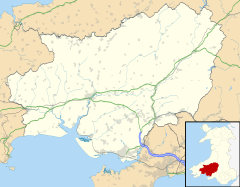| Revision as of 02:56, 7 April 2019 editIra Leviton (talk | contribs)Extended confirmed users332,052 editsm Fixed a typo found with Misplaced Pages:Typo_Team/moss, changed semicolons to commas.← Previous edit | Revision as of 22:20, 1 May 2019 edit undoAgricolae (talk | contribs)Extended confirmed users, Pending changes reviewers31,009 edits redlink, page-creation in processNext edit → | ||
| Line 32: | Line 32: | ||
| One mile to the west is the ] of Waunclunda, and above Waunclunda is an ancient fort. Little information is available about this fort, but it is believed to have been an Iron age and then a Roman fort it is believed to be important for its potential archeology<ref>{{Cite web|url=https://ancientmonuments.uk/129563-fan-camp-llansadwrn|title=Fan Camp, Llansadwrn, Carmarthenshire (Sir Gaerfyrddin)|last=Stuff|first=Good|website=ancientmonuments.uk|access-date=2019-01-21}}</ref>. | One mile to the west is the ] of Waunclunda, and above Waunclunda is an ancient fort. Little information is available about this fort, but it is believed to have been an Iron age and then a Roman fort it is believed to be important for its potential archeology<ref>{{Cite web|url=https://ancientmonuments.uk/129563-fan-camp-llansadwrn|title=Fan Camp, Llansadwrn, Carmarthenshire (Sir Gaerfyrddin)|last=Stuff|first=Good|website=ancientmonuments.uk|access-date=2019-01-21}}</ref>. | ||
| The village is also believed to be the site of an important manor, Abermarlais Castle<ref>{{Cite web|url=http://www.gatehouse-gazetteer.info/Welshsites/179.html|title=Abermarlais Castle (The Gatehouse Record)|website=www.gatehouse-gazetteer.info|access-date=2019-01-21}}</ref> a fortified mansion, built in about the C14 (Rees 1932), it was home to Sir Rhys ap Gruffydd who commanded the Welsh at Crécy (Jones 1987, 4). In the 1600s it was noted to have had 21 hearths - making it a notable house<ref>{{Cite web|url=http://www.dyfedarchaeology.org.uk/HLC/HLCTowy/area/area209.htm|title=Archaeology in Wales - Ymddiriedolaeth Archaeolegol Dyfed - Dyfed Archaeological Trust|website=www.dyfedarchaeology.org.uk|access-date=2019-01-21}}</ref>. Also in the village is a and Roman road. | The village is also believed to be the site of an important manor, Abermarlais Castle<ref>{{Cite web|url=http://www.gatehouse-gazetteer.info/Welshsites/179.html|title=Abermarlais Castle (The Gatehouse Record)|website=www.gatehouse-gazetteer.info|access-date=2019-01-21}}</ref> a fortified mansion, built in about the C14 (Rees 1932), it was home to ] who commanded the Welsh at Crécy (Jones 1987, 4). In the 1600s it was noted to have had 21 hearths - making it a notable house<ref>{{Cite web|url=http://www.dyfedarchaeology.org.uk/HLC/HLCTowy/area/area209.htm|title=Archaeology in Wales - Ymddiriedolaeth Archaeolegol Dyfed - Dyfed Archaeological Trust|website=www.dyfedarchaeology.org.uk|access-date=2019-01-21}}</ref>. Also in the village is a and Roman road. | ||
| ==References== | ==References== | ||
Revision as of 22:20, 1 May 2019
This article is about the village in Carmarthenshire. For the village in Anglesey, see Llansadwrn, Anglesey. Human settlement in Wales| Llansadwrn | |
|---|---|
 | |
 | |
| Population | 517 (2011) |
| Community |
|
| Principal area | |
| Preserved county | |
| Country | Wales |
| Sovereign state | United Kingdom |
| Post town | Llanwrda |
| Postcode district | SA19 8 |
| Dialling code | 01550 |
| Police | Dyfed-Powys |
| Fire | Mid and West Wales |
| Ambulance | Welsh |
| UK Parliament | |
| Senedd Cymru – Welsh Parliament | |
| |


Llansadwrn is a small village and community in Carmarthenshire, Wales.
It is located in the countryside above the valley of the River Tywi, about halfway between Llanymddyfri (or Llandovery) to the north-east, and Llandeilo to the south-west. It is just off the A40 road, between Carmarthen (about 20 miles SW) and Brecon (about 25 miles E). The community is bordered by the communities of Cynwyl Gaeo, Llanwrda, Myddfai, Llangadog, Manordeilo and Salem, and Talley; all of these are in Carmarthenshire.
History
According to tradition, it was founded by an early Christian saint, Sadwrn (fl. around 460).
Four miles to the west of the village are the ruins of Talley Abbey (Template:Lang-cy).
One mile to the west is the hamlet of Waunclunda, and above Waunclunda is an ancient fort. Little information is available about this fort, but it is believed to have been an Iron age and then a Roman fort it is believed to be important for its potential archeology.
The village is also believed to be the site of an important manor, Abermarlais Castle a fortified mansion, built in about the C14 (Rees 1932), it was home to Sir Rhys ap Gruffydd who commanded the Welsh at Crécy (Jones 1987, 4). In the 1600s it was noted to have had 21 hearths - making it a notable house. Also in the village is a Bronze age standing stone and Roman road.
References
- "Community population 2011". Retrieved 13 April 2015.
- Stuff, Good. "Fan Camp, Llansadwrn, Carmarthenshire (Sir Gaerfyrddin)". ancientmonuments.uk. Retrieved 2019-01-21.
- "Abermarlais Castle (The Gatehouse Record)". www.gatehouse-gazetteer.info. Retrieved 2019-01-21.
- "Archaeology in Wales - Ymddiriedolaeth Archaeolegol Dyfed - Dyfed Archaeological Trust". www.dyfedarchaeology.org.uk. Retrieved 2019-01-21.
External links
- www.geograph.co.uk : photos of Llansadwrn and surrounding area
- https://www.llansadwrn.org.uk/ community website
- https://ancientmonuments.uk/129563-fan-camp-llansadwrn#.XEX4xlz7S00
This Carmarthenshire location article is a stub. You can help Misplaced Pages by expanding it. |